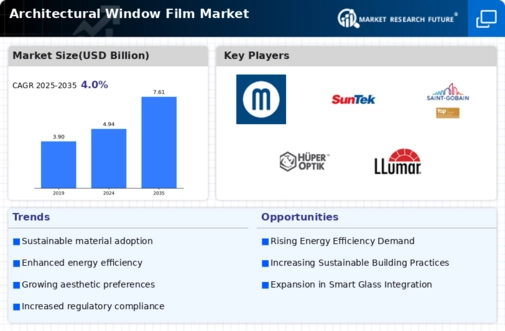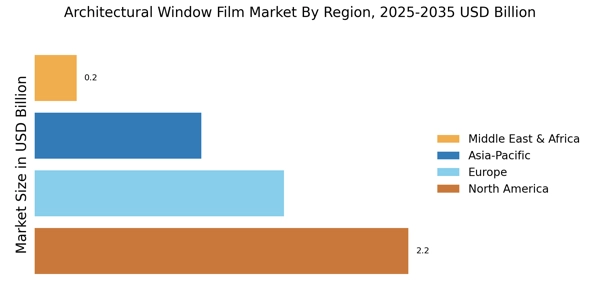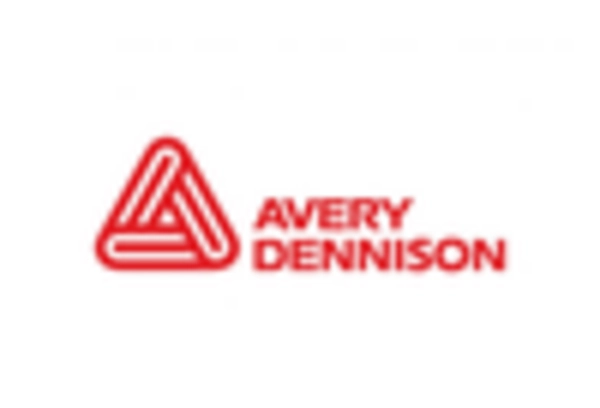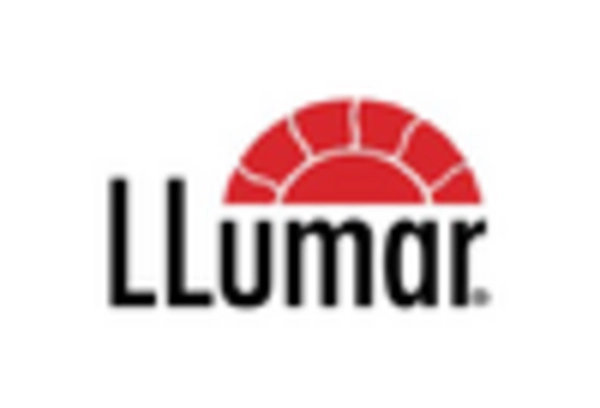Energy Efficiency Demand
The Architectural Window Film Market is experiencing a notable surge in demand for energy-efficient solutions. As energy costs continue to rise, consumers and businesses alike are increasingly seeking ways to reduce their energy consumption. Architectural window films provide an effective means to enhance insulation, thereby lowering heating and cooling costs. According to recent data, buildings equipped with window films can achieve energy savings of up to 30%. This growing emphasis on energy efficiency is likely to drive the market forward, as more stakeholders recognize the long-term financial benefits associated with these films. Furthermore, regulatory frameworks promoting energy conservation are expected to bolster the adoption of architectural window films, making them a preferred choice for both residential and commercial applications.
Rising Construction Activities
The Architectural Window Film Market is poised for growth due to the rising construction activities across various sectors. As urbanization continues to expand, there is an increasing demand for new residential and commercial buildings. Architectural window films are becoming a popular choice among builders and architects, as they enhance the aesthetic appeal of structures while providing functional benefits such as energy efficiency and UV protection. Recent statistics indicate that the construction sector is projected to grow at a compound annual growth rate of approximately 5% over the next few years. This trend is likely to create a robust market for architectural window films, as more projects incorporate these innovative solutions into their designs.
Increased Awareness of UV Protection
The Architectural Window Film Market is witnessing a heightened awareness regarding the harmful effects of ultraviolet (UV) radiation. Consumers are becoming increasingly informed about the potential health risks associated with prolonged sun exposure, including skin cancer and premature aging. Architectural window films offer a practical solution by blocking up to 99% of harmful UV rays, thus protecting both occupants and furnishings from damage. This growing concern for health and safety is likely to propel the demand for window films, particularly in residential settings where families prioritize protective measures. Additionally, the integration of UV protection features into marketing strategies may further enhance consumer interest, positioning architectural window films as essential components of modern building design.
Regulatory Support for Energy Efficiency
The Architectural Window Film Market is benefiting from a favorable regulatory environment that promotes energy efficiency in buildings. Governments and regulatory bodies are increasingly implementing standards and incentives aimed at reducing energy consumption and greenhouse gas emissions. These initiatives often include tax credits, rebates, and grants for energy-efficient upgrades, which can encompass the installation of architectural window films. As a result, property owners are more inclined to invest in these solutions, knowing that they may receive financial support. This regulatory backing not only encourages the adoption of window films but also aligns with broader sustainability goals, making it a pivotal driver for the market's growth in the coming years.
Technological Innovations in Film Production
The Architectural Window Film Market is experiencing a wave of technological innovations that are enhancing the performance and appeal of window films. Advances in manufacturing processes have led to the development of films that offer superior durability, clarity, and energy efficiency. Innovations such as nano-coating technologies and multi-layered films are becoming increasingly prevalent, allowing for greater customization and functionality. These advancements not only improve the overall quality of architectural window films but also expand their applications in various settings. As consumers and businesses seek high-performance solutions, the demand for technologically advanced window films is likely to rise, further propelling the growth of the architectural window film market.


















Leave a Comment